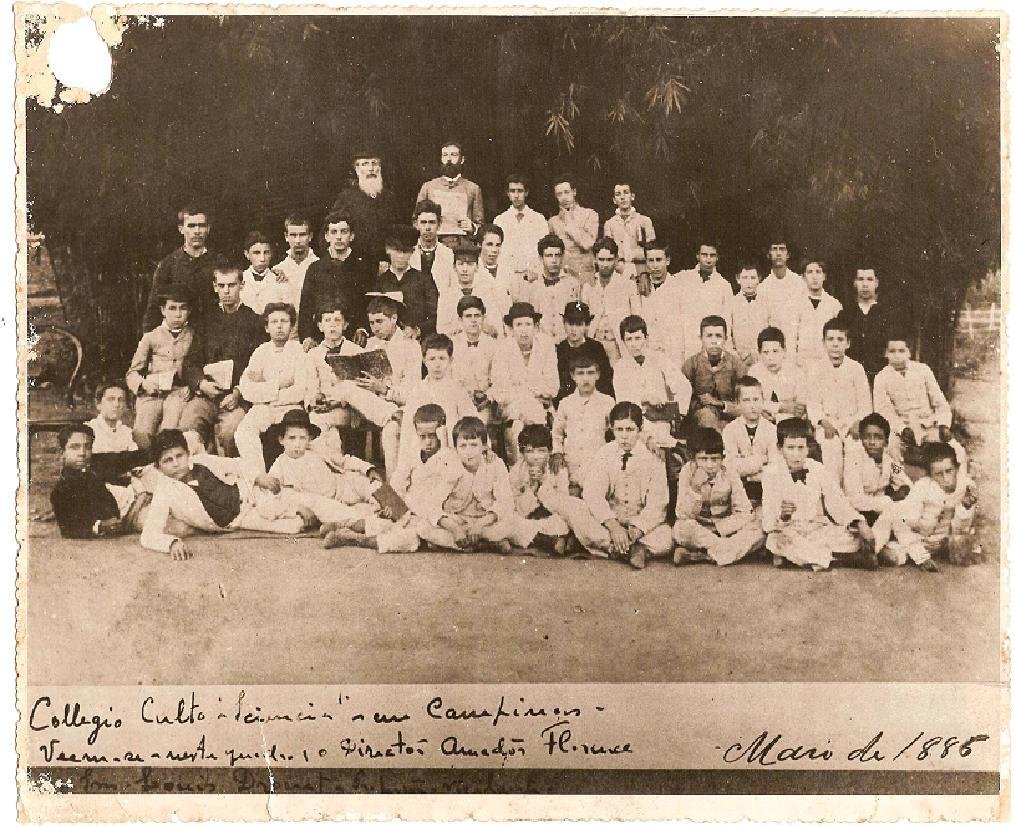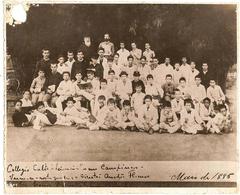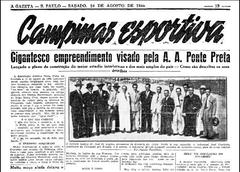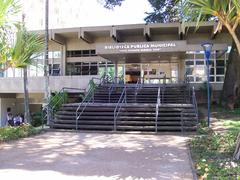
Complete Guide to Colégio Culto À Ciência: Visiting Hours, Tickets, and Historical Significance in Campinas, Brazil
Date: 15/06/2025
Introduction: History, Cultural Importance, and What to Expect
Located in the heart of Campinas, São Paulo, Colégio Culto À Ciência is among Brazil’s most iconic educational institutions and a significant historical site. Founded in 1873 by leading intellectuals and civic leaders—including Francisco Glicério and Joaquim Bonifácio do Amaral—the school was conceived as a beacon for secular, science-based education at a time when religious instruction prevailed. Its name, “Culto À Ciência” (“Cult of Science”), and the motto “Libertas per Scientiam” (“Freedom through Science”) reflect Enlightenment values: rationality, scientific inquiry, and civic responsibility (Colégio Culto à Ciência - História).
The school’s neoclassical architecture, storied academic innovations, and progressive social policies—such as early coeducation—have established it as a cultural touchstone in Campinas. Evolving from a private institution for the city’s elite to a renowned public school, Colégio Culto À Ciência is celebrated for its academic excellence, commitment to social inclusion, and role in political and cultural transformation, especially throughout Brazil’s 20th-century history (Wikipedia; Campinas.com.br).
Today, visitors can explore the preserved campus, marvel at terracotta decorations and wrought iron balconies, and enjoy guided tours—available by appointment or during special events—that reveal the institution’s profound impact on Brazilian education and society (iabcampinas.org.br). This guide details the school’s history, architectural highlights, cultural significance, practical visiting information, and tips for making the most of your experience at one of Campinas’ most treasured sites (Colégio Culto à Ciência - Visitação).
Table of Contents
- Founding and Early Years (1873–1900)
- Institutional Evolution and Modernization (1900–1950)
- Role in Brazilian Education and Society (1950–2000)
- Architectural and Cultural Heritage
- Recent Developments and Contemporary Significance
- Visiting Colégio Culto À Ciência: Hours, Tickets, and Practical Information
- Visual and Interactive Media
- Frequently Asked Questions (FAQ)
- Explore More and Stay Connected
Founding and Early Years (1873–1900)
Colégio Culto À Ciência was established in 1873 during Campinas’ economic and urban expansion. Its founders—visionaries like Francisco Glicério and Joaquim Bonifácio do Amaral—sought to create a modern, secular alternative to the dominant religious education of the era (Colégio Culto à Ciência - História). The school’s Enlightenment-inspired name and curriculum, which prioritized the sciences, mathematics, languages, and humanities, set it apart from traditional schools.
Initially operating from a modest building, the school’s burgeoning reputation led to the construction of its current, purpose-built facility on Rua Culto à Ciência in 1897—a site that remains a hallmark of Campinas architecture (Patrimônio Histórico de Campinas).
Institutional Evolution and Modernization (1900–1950)
The early 20th century saw Colégio Culto À Ciência at the forefront of educational reform, reflecting broader societal changes as Brazil transitioned from monarchy to republic. In 1908, the school began admitting female students, becoming a pioneer in gender equality in education (História da Educação em Campinas). The curriculum expanded to include new scientific disciplines and foreign languages, and the faculty increasingly featured educators active in civic and political life.
Campus enhancements included new laboratories, a library, and sports facilities. The school’s neoclassical main building became a symbol of Campinas’ commitment to educational advancement.
Role in Brazilian Education and Society (1950–2000)
Colégio Culto À Ciência became a leading public school in the 1950s, democratizing education by welcoming students from diverse backgrounds (Secretaria da Educação do Estado de São Paulo). Known for academic rigor and success in university entrance exams and national competitions, the school also flourished as a center for cultural activities—hosting theater, music, and literary events that enriched Campinas’ cultural life.
During the military dictatorship (1964–1985), it played a crucial role as a hub of political engagement and advocacy for democratic ideals (Memória da Educação Brasileira).
Architectural and Cultural Heritage
The main building, dating from the late 19th century, showcases neoclassical features—columns, arched windows, and ornate moldings. Heritage status was conferred in 1983 by CONDEPHAAT, ensuring the preservation of the campus and its architectural legacy (CONDEPHAAT - Tombamento).
Gardens, courtyards, and sports fields surround the historic structure, while interiors—such as the auditorium and library—retain original detailing and house historical archives. The school regularly hosts exhibitions and public lectures, maintaining its cultural and intellectual significance.
Recent Developments and Contemporary Significance
In the 21st century, Colégio Culto À Ciência has embraced technological innovation and forged partnerships with institutions like UNICAMP (UNICAMP Parcerias). The school’s students continue to excel academically, supported by an engaged alumni network that champions scholarships, cultural projects, and community outreach.
The enduring motto, “Libertas per Scientiam,” encapsulates its mission to empower students and foster leadership.
Visiting Colégio Culto À Ciência: Hours, Tickets, and Practical Information
Visiting Hours:
Monday through Friday, 9:00 AM to 5:00 PM. Guided tours are available by appointment or during special events. Weekend visits may be arranged in advance.
Tickets:
Admission is free. Special events or exhibitions may require registration or a nominal fee. Check the official visitation page for current details.
Accessibility:
The campus is wheelchair accessible, with ramps and adapted restrooms. Contact the administration for specific accessibility needs.
Guided Tours:
Available in Portuguese and, upon request, English. Tours include the main building, library, auditorium, gardens, and archival exhibits. Advance booking is advised.
Location and Travel Tips:
Located at Rua Culto à Ciência, 177, central Campinas. Accessible by public transport and near other historical sites—such as Mercado Municipal and Campinas Cathedral.
Photography:
Allowed in outdoor areas; interior photography may require permission.
Visual and Interactive Media
The official website offers virtual tours, images of architectural highlights, and video interviews with alumni and faculty, providing valuable context and planning tools for visitors.
Frequently Asked Questions (FAQ)
Q: What are the visiting hours?
A: Monday to Friday, 9:00 AM to 5:00 PM; weekends by appointment.
Q: Is there an entrance fee?
A: Admission is free; some events may require registration or a nominal fee.
Q: Are guided tours available?
A: Yes, by appointment and during cultural events; available in Portuguese and English.
Q: Is the site accessible?
A: Yes, with ramps and adapted facilities.
Q: Can I take photographs?
A: Yes, in outdoor areas; permission is needed for indoor photography.
Q: What other attractions are nearby?
A: Mercado Municipal, Campinas Cathedral, and several museums.
Explore More and Stay Connected
For updates on events, visiting hours, and exhibitions, visit the official website or follow Colégio Culto À Ciência on social media. Download the Audiala app for interactive guides, event calendars, and exclusive content.
Architectural Overview and Recent Restorations
The school’s two-story building, inaugurated in 1874, is a prime example of late 19th-century educational architecture. Constructed with exposed brick in the Flemish bond system, its façade features terracotta cornices, ornamental pinecones, wrought iron balconies, and decorative vases (iabcampinas.org.br). Interior spaces include classrooms, a library with rare books, and preserved historical details.
Throughout the 20th and 21st centuries, the campus has been meticulously restored, supported by alumni and state funding. Major works have focused on restoring the roof, decorative elements, and front gardens, while modern upgrades ensure accessibility and technological relevance (campinas.com.br).
Heritage status, conferred by CONDEPHAAT and CONDEPACC, mandates the preservation of all architectural features.
Tips for a Memorable Visit
- Plan ahead: Confirm visiting hours and tour availability.
- Join a guided tour: Gain deeper insights into the school’s history and architecture.
- Respect the academic environment: Some areas may be off-limits during school hours.
- Accessibility: Notify staff in advance of any special needs.
- Explore nearby attractions: Enjoy other cultural sites within walking distance.
Safety and Preservation
The campus is monitored and access is controlled for visitor safety. Consider supporting preservation efforts through donations.
Call to Action
Immerse yourself in the living history of Colégio Culto À Ciência. Download the Audiala app for guided audio tours and real-time event updates, and follow the school’s official channels to stay connected with Campinas’ educational and cultural heritage.
References
- Colégio Culto à Ciência - História
- Wikipedia: Colégio Culto à Ciência
- Campinas.com.br - Colégio Estadual Culto à Ciência
- iabcampinas.org.br - Culto à Ciência Identity
- Colégio Culto à Ciência - Visitação
- Wikipedia PT: Escola Estadual Culto à Ciência
- Correio RAC article
- Escol.as profile





